It seems like summer was just yesterday but the truth is, it’s almost November and next summer will be here before you know it. It’s never to soon to start planning for next summer. Digital Media Academy is celebrating their shiny new website and an exciting new summer camp lineup with deep discounts on all of our course offerings now through November 4th!
Save up to $250 during the Launch Sale and discover exciting new summer camps and courses for your kid or teen ages 6-17. Since 2002, Digital Media Academy has set out to be the thought-leader in tech education for kids, teens and adults at prestigious universities across the U.S. and Canada.

In addition to summer camp programs, DMA offers year-round learning via DMA Online and powers tech ed programs through its curriculum licensing program around the globe. DMA instructors and curriculum developers include industry professionals and outstanding technology educators, with a driving passion for inspiring, teaching, and mentoring.
What will you create this summer? Don’t wait – the Launch Sale ends November 4, 2016!

Balanced Experience
DMA camps offer more than sitting in front of a screen all day. The DMA learning experience strikes a balance between tech time and social time; sending our campers home with new tech skills and confidence and new friends.
Top-Notch Staff
The DMA staff is an impressive group of industry professionals and tech educators who are passionate about sharing their knowledge and experience. Small staff to student ratios keep learning personalized and ensures that no one gets left behind.

Project-Based
Students learn by getting hands on and collaborative in search of solutions to relative, real world problems. Infused with design-thinking methodology, our courses teach students to lead with empathy, test and retest through prototyping, and work as a team to get results.

Safety Matters
Your child’s safety is DMA’s top priority. All DMA staff are trained and certified in CPR and First Aid. Our security procedures ensure that our students are safe on campus, in the classroom, and online so that you don’t ever have to worry.

Learn more here:


 TV Listings: Image from Wikipedia
TV Listings: Image from Wikipedia The Old Familiar Buffering Screen: Image from Flickr
The Old Familiar Buffering Screen: Image from Flickr TV Box Sets For All The Family?: Image from Flickr
TV Box Sets For All The Family?: Image from Flickr Pic
Pic Image:
Image:  Flickr Image
Flickr Image Wikipedia Image
Wikipedia Image Wikipedia Image
Wikipedia Image Flickr Image
Flickr Image PixaBay Image
PixaBay Image











